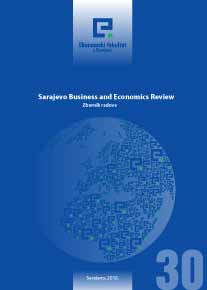Dimenzije i obilježja krize preduzeća u BiH
Dimensions and Caracteristics of the Companies in Crisis in Bosnia And Herzegovina
Author(s): Senad SoftićSubject(s): Economy
Published by: Ekonomski fakultet u Sarajevu
Keywords: Company in Crisis; Symptoms of Crisis; Causes of Crisis; Organizational turnover
Summary/Abstract: This research provides insight into the scope and intensity of the crisis of the companies in Bosnia and Herzegovina and, on the other hand, presents specific characteristics of the BiH companies with business crisis. We are the witnesses of a rising number of companies with significant problems such as chronic insolvency, heavy debt, a significant number of employees with terminated employment contract as well as frequent cases of the close-downs of the factories and liquidation/bankruptcy of the companies. General as well as individual indicators of business activities of the companies in Bosnia and Herzegovina (losses, debts, insolvency) lead to the conclusion that majority of business results are unsatisfactory. For example, in Bosnia and Herzegovina over 500 bankruptcy procedures have been initiated but not completed. Further on, in accordance with official statistical results a number of companies with reported business losses is increasing. During 2009, over 30% of the companies reported business losses. At the same time, amounts of reported losses are higher and higher, reaching the total amount of acc. 2 billion KM. Concerning the fact is that approximately 100.000 employees lost jobs over the last two years. Therefore, it can be justifiably stated that a major number of the companies in Bosnia and Herzegovina is facing with business crises. Aimed to support this paper, presented are the parts of the comprehensive research of the companies in crisis in Bosnia and Herzegovina which includes significant number of companies from the territory of Bosnia and Herzegovina and their business operations in the period from 2006 to 2009. Conducted research was supported by the use of several scientific methods which were classified under general and specialized scientific methods e.g. methods for collection of primary and secondary data with emphasis to a desk research of all companies with reported business loss in 2008 as well as gatherings of the qualitative information and data resulting from the questionnaires completed with the sample of 63 companies. Apart from mentioned above, statistical and comparative methods for data processing and analysis have been used.
Journal: Zbornik radova - Sarajevo Business and Economics Review (SBER)
- Issue Year: 2010
- Issue No: 30
- Page Range: 236-261
- Page Count: 26
- Language: Bosnian

